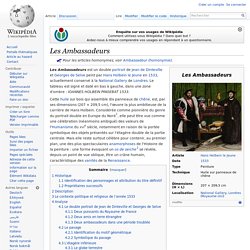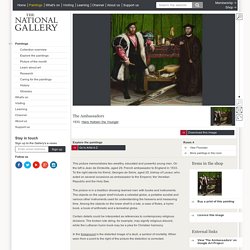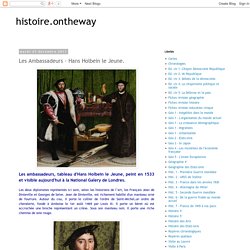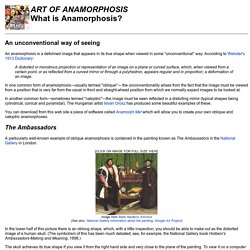

Les Ambassadeurs. Un article de Wikipédia, l'encyclopédie libre.

Les Ambassadeurs est un double portrait de Jean de Dinteville et Georges de Selve peint par Hans Holbein le Jeune en 1533, actuellement conservé à la National Gallery de Londres. Le tableau est signé et daté en bas à gauche, dans une zone d'ombre : IOANNES HOLBEIN PINGEBAT 1533. Historique[modifier | modifier le code] Identification des personnages et attribution du titre définitif[modifier | modifier le code] Propriétaires successifs[modifier | modifier le code] Description[modifier | modifier le code]
Symbolism in Holbein's 'Ambassadors' Hans Holbein the Younger. This picture memorialises two wealthy, educated and powerful young men.

On the left is Jean de Dinteville, aged 29, French ambassador to England in 1533. To the right stands his friend, Georges de Selve, aged 25, bishop of Lavaur, who acted on several occasions as ambassador to the Emperor, the Venetian Republic and the Holy See. The picture is in a tradition showing learned men with books and instruments. The Ambassadors - Hans Holbein the Younger - Google Cultural Institute. Ambassadeurs d'Holbein et géopolitique. L'Art en Question 6 : Les Ambassadeurs de Holbein (version courte) - Peut-on vaincre la mort ? (9 min) Soutenez la production et la diffusion de cette nouvelle série.

En savoir plus.Objectif: Hda-holbein-artsespacetemps.pdf. A closer look at Hans Holbein’s “The Ambassadors” September 13, 2013 by artstor Hans Holbein the Younger | Jean de Dinteville and Georges de Selve (‘The Ambassadors’) | 1533 | The National Gallery, London | Photograph ©The National Gallery, London Hans Holbein the Younger’s “The Ambassadors” of 1533 memorializes Jean de Dinteville, French ambassador to England, and his friend, Georges de Selve, who acted on several occasions as French ambassador to the Republic of Venice, to the Pope in Rome, and to England, Germany, and Spain.

The painting is well known for its anamorphic image of a skull in the foreground, but upon close perusal, the objects on the table between the two men prove just as fascinating. The upper shelf, which is concerned with the the heavens, includes a celestial globe, a portable sundial, and various other instruments used for understanding the heavens and measuring time, while the lower shelf, which reflects the affairs of the world, holds musical instruments, a hymn book, a book of arithmetic, and a terrestrial globe. Histoire.ontheway: Les Ambassadeurs - Hans Holbein le Jeune. Les ambassadeurs, tableau d'Hans Holbein le Jeune, peint en 1533 et visible aujourd'hui à la National Galery de Londres.

Les deux diplomates représentés ici sont, selon les historiens de l’art, les Français Jean de Dinteville et Georges de Selve. Jean de Dinteville, est richement habillé d'un manteau orné de fourrure. Autour du cou, il porte le collier de l'ordre de Saint-Michel,un ordre de chevalerie, fondé à Amboise le 1er août 1469 par Louis XI. Il porte un béret où est accrochée une broche représentant un crâne. Sous son manteau noir, il porte une riche chemise de soie rouge. Holbein.pdf. Anamorphosis. Example of mirror anamorphosis Anamorphosis is a distorted projection or perspective requiring the viewer to use special devices or occupy a specific vantage point to reconstitute the image.

The word "anamorphosis" is derived from the Greek prefix ana‑, meaning back or again, and the word morphe, meaning shape or form. Types of projection[edit] There are two main types of anamorphosis: perspective (oblique) and mirror (catoptric). Examples of perspectival anamorphosis date to the early Renaissance (fifteenth century). With mirror anamorphosis, a conical or cylindrical mirror is placed on the drawing or painting to transform a flat distorted image into a three-dimensional picture that can be viewed from many angles. History[edit] Leonardo's Eye (Leonardo da Vinci, c. 1485) is the earliest known definitive example of perspective anamorphosis in modern times.
Anamorphosis could be used to conceal images for privacy or personal safety. Practical uses[edit] Impossible objects[edit] What is anamorphosis? An unconventional way of seeing An anamorphosis is a deformed image that appears in its true shape when viewed in some "unconventional" way.

According to Webster's 1913 Dictionary: A distorted or monstrous projection or representation of an image on a plane or curved surface, which, when viewed from a certain point, or as reflected from a curved mirror or through a polyhedron, appears regular and in proportion; a deformation of an image. In one common form of anamorphosis---usually termed "oblique"--- the unconventionality arises from the fact that the image must be viewed from a position that is very far from the usual in-front and straight-ahead position from which we normally expect images to be looked at. In another common form---sometimes termed "catoptric"---the image must be seen reflected in a distorting mirror (typical shapes being cylindrical, conical and pyramidal).
You can download from this web site a piece of software called Anamorph Me! The Ambassadors "...